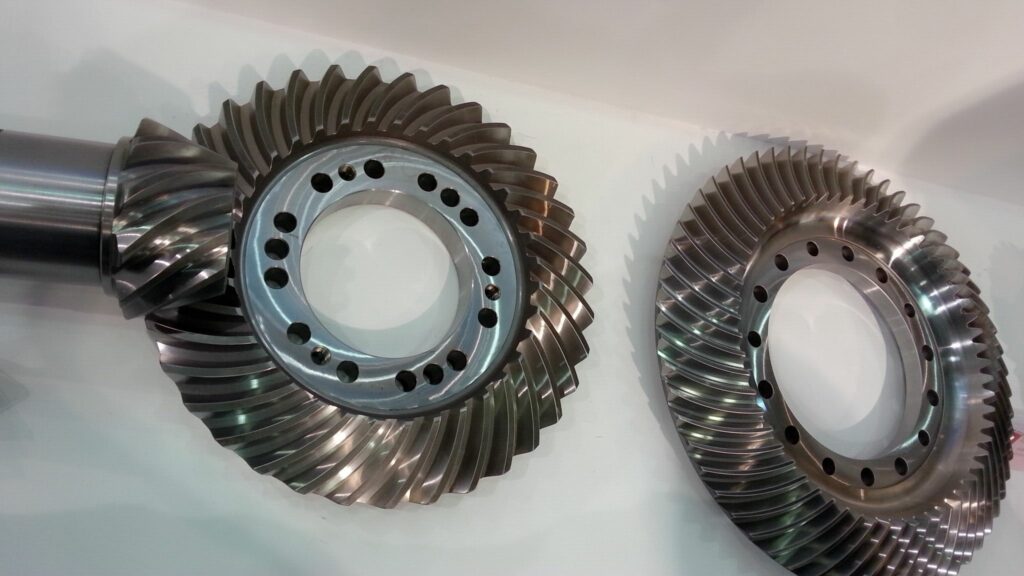Improving gear transmission accuracy is not a single-step improvement but a comprehensive engineering process. It requires precise control across the entire chain, from design, materials, manufacturing, heat treatment, and inspection, to assembly and lubrication. Below is a detailed, professional, and practical guide for enhancing gear accuracy across multiple dimensions:
1. Design Optimization: The Foundation of Precision
1.1 Precision Grade Selection:
- Select the ISO or AGMA gear accuracy grade (e.g., ISO 1328 grade 4-6 for high-precision applications) based on motion, stability, and contact requirements.
- Feasibility: Avoid over-specifying; define achievable and cost-effective accuracy levels.
1.2 Gear Geometry Enhancements:
- Crowning: Add slight curvature along tooth width to compensate for misalignment and shaft deformation.
- Tip/Root Relief: Slightly relieve tooth tips or roots to reduce impact during mesh-in/mesh-out.
- Higher Contact Ratio: Increase face width, reduce module (if strength allows), or use helical gears with optimized helix angles.
- Pressure Angle Optimization: Increasing pressure angle (e.g., to 25°) improves root strength and reduces elastic deflection but increases bearing load.
- Profile and Lead Modifications:
- Profile modification reduces transmission error.
- Lead modification compensates for shaft misalignment and deflection.
- Topography Optimization: Use 3D tooth surface design based on real load, temperature, and deformation scenarios.
- Feasibility: Modern CAE tools (e.g., Romax, MASTA, KISSsoft) and CNC gear grinders support complex modifications.
1.3 Thermal Deformation Compensation:
- Anticipate material expansion and geometry shift due to temperature rise and include offset designs accordingly.
- Feasibility: Utilize thermal-mechanical simulations and empirical data.
2. Material and Heat Treatment: The Backbone of Stability
2.1 Material Selection:
- Use high-hardenability alloy steels (e.g., 20CrMnTiH, 17CrNiMo6, 8620H, 9310).
- For ultra-low deformation, consider nitriding steels (e.g., 38CrMoAlA) or induction hardening steels.
- Feasibility: Ensure supply stability and control of material purity and hardenability range.
2.2 Advanced Heat Treatment:
- Carburizing and Quenching: Precisely control case depth, surface hardness (58-62 HRC), and core gradient.
- Nitriding: Control compound layer thickness and brittleness; use ion nitriding for minimal distortion.
- Induction Hardening: Localized hardening with accurate control over zone and depth.
- Stabilization (Cryo/Double Tempering): Reduce residual austenite and ensure structural stability.
- Feasibility: Implement with vacuum furnaces, controlled-atmosphere furnaces, and tight process monitoring.
3. High-Precision Manufacturing: The Core Process
3.1 Gear Blank Preparation:
- Ensure machining accuracy of reference surfaces (bore, end face) in terms of roundness, perpendicularity, and surface finish.
- Feasibility: CNC lathes and precision grinding.
3.2 Gear Cutting Process Routes:
- Option 1 (Mainstream): Hobbing → Heat Treatment → Precision Grinding.
- Option 2 (Economical): Hobbing → Shaving → Heat Treatment → Honing.
- Option 3 (Highest Precision): Hobbing → Heat Treatment → Rough Grinding → Finish Grinding → Superfinishing.
- Soft Teeth (High Precision): Precision hobbing/shaping → Precision shaving → Heat Treatment → Honing.
- Feasibility: Choose based on precision, cost, and application.
3.3 Critical Tooth Processing Techniques:
- Use high-end CNC gear grinders (e.g., Reishauer, Kapp, Niles).
- Accurately dress grinding wheels and optimize grinding parameters to avoid burns and stress.
- Apply in-process compensation (e.g., Kapp PEC system).
- Control room temperature (±1°C).
- Honing/Shaving: Ensure high-quality cutting tools and optimized feed rates.
- Feasibility: Advanced equipment and strict process standards.
4. Precision Inspection and Feedback Control
4.1 Complete Gear Inspection:
- Geometrical Accuracy: Tooth spacing, profile deviation, lead deviation, runout (with gear measuring centers).
- Comprehensive Accuracy: Single/double flank testing for transmission error and center distance variation.
- Surface Quality: Surface roughness (Ra/Rz) and burn detection.
- Hardness Layer and Microstructure: Check effective case depth and hardness gradient.
4.2 Data-Driven Feedback:
- Use inspection data to adjust machining parameters (e.g., in-process compensation).
- Conduct SPC to identify variation trends.
- Feasibility: Closed-loop quality control with modern metrology.
5. Precision Assembly and Installation
5.1 Housing and Support:
- Ensure coaxiality, perpendicularity, and center distance tolerances of bearing bores.
- Feasibility: High-precision machining centers or jig borers.
5.2 Shaft and Alignment:
- Control shaft roundness, coaxiality, and stiffness.
- Feasibility: Precision grinding.
5.3 Bearings:
- Use high-grade bearings (e.g., P4/P2).
- Control internal clearance and preload precisely.
- Fit tolerances must ensure proper mounting.
5.4 Gear Mounting:
- Ensure tight fits without clearance; maintain low runout.
- Apply locking mechanisms evenly and avoid tilt.
5.5 Alignment:
- Use laser alignment tools or dial indicators for precise axis parallelism.
- Feasibility: Set strict assembly procedures and use skilled technicians.
6. Lubrication and Thermal Management
6.1 Lubricant Selection:
- Use proper viscosity oils (e.g., ISO VG 68, 100) with good EP, oxidation, and anti-foam properties.
- For extreme loads, consider grease with MoS2.
- Feasibility: Select from industrial-grade lubricants.
6.2 Lubrication Method:
- Ensure proper lubrication to mesh zone via oil bath or spray with optimized nozzles.
- Maintain oil cleanliness with filtration.
6.3 Thermal Control:
- Design for heat dissipation (e.g., cooling fins, fans).
- For high-load systems, apply forced oil circulation or water cooling.
- Feasibility: Standard or custom cooling solutions.
By addressing these dimensions with technical depth and engineering rigor, gear transmission precision can be significantly enhanced. This systematic approach not only improves performance and lifespan but also ensures consistency, reliability, and value for high-end mechanical systems.
Thank you for reading. We are looking forward to serving you with our exceptional gear solutions. #BeyondGears
Read More:


